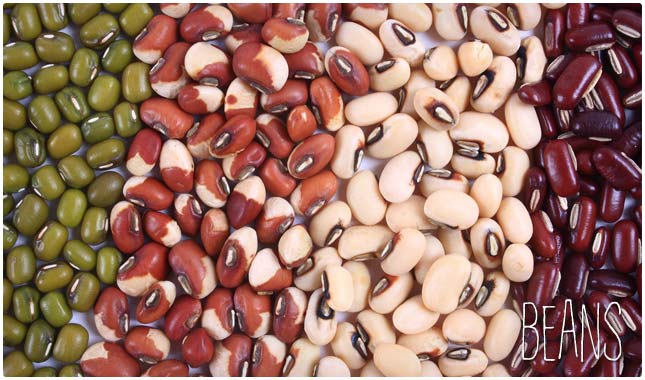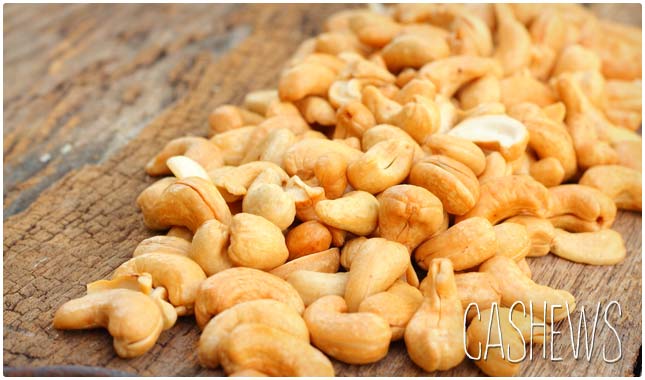
Eating a diet rich in low glycemic foods is one way to help keep your blood sugar levels where you want them. It’s not the most foolproof method out there, but it does provide some indication as to how your body will react to a certain food, and at a glance you can see which foods are better for you than others in this regard. You’ll want to use your own judgment when choosing low GI foods because as we’ll see there are some that may have a low glycemic rank, but are not the healthiest choice you can make.
For reference, a GI rank of 55 or lower is considered Low.
[hr]

1. Oats
Oats have long been considered a good food for diabetics as well as those looking to prevent getting diabetes because it helps to keep blood sugar levels stable for several hours. It also provides a good amount of fiber, and is recommended for those trying to manage their cholesterol levels and blood pressure levels as well. This makes it a great overall healthy food that you can enjoy as a way to start your day on the right food and keep your energy up without spiking your blood glucose. Glycemic Index Rank: 59
[hr]
2. Peas
Peas are a great side dish to just about any meat-based entre, as they don’t add much in the way of calories at just 81 calories in a 100 gram serving. They also have a fair amount of potassium, and are relatively high in fiber as well. You’ll be getting a boost of vitamin C along with your serving of peas, and they even have a good amount of protein in them. It’s always nice when a low glycemic food helps you in other ways and is considered healthy, since your goal is overall health and wellbeing, as well as keeping your weight at a good number. Glycemic Index Rank: 22
[AdSense-A]
3. Carrots
Carrots have a very low number on the glycemic scale at 16. Considering that 55 or lower means it’s low, that is exceptionally low. We all know that the beta carotene in carrots helps with eyesight, and there’s no doubt that it’s high in vitamin A. There’s also some fiber in there as well to help with the digestive system. Peas and carrots are a nice combination, and you can freely mix those two together as a delicious side while keeping within your glycemic concerns. Like any food, just because it scores low doesn’t mean you should eat a lot of it in one sitting. Glycemic Index Rank: 16
4. Broccoli
Is there anything broccoli can’t do? It’s a superfood that shows up on plenty of different healthy foods lists, including being an anti-inflammatory food, a good to help you prevent cancer, and plenty more. Here it’s coming in with the very low score of 15 on the GI scale, so the body can handle it very easily without an increase in blood sugar. This is one reason why broccoli makes a great side dish. It provides you with plenty of fiber, protein, vitamins and minerals so you end up getting a nice nutritional spread from just one food. Glycemic Index Rank: 15
5. Cabbage
Cabbage is often used as a dietary food because of its low calorie and fat count, and you can also count it among one of the lowest glycemic foods on the planet. It clocks in at 10, well below the level that qualifies a food as low. Cabbage is also very versatile, finding its way into many main dish recipes, working as a nice side when steamed until soft, and providing texture, flavor, and nutrition to soups. It even provides a dose of vitamin C so you’re strengthening your immune system at the same time. Glycemic Index Rank: 10
[hr]

6. Kale
Kale is a legitimate superfood, so you can fully enjoy it without any worries that it will bump your blood glucose levels in the slightest. While there aren’t official counts as to where kale ends up on the Glycemic Index, it is theorized that it is very low, and less than a 15. Kale provides plenty of vitamin A and vitamin C, gives you a fiber kick, has almost as much potassium as a banana, gives you iron and is very low in fat and calories. This makes it a great addition to your regular intake of fruits and vegetables. Glycemic Index Rank: 15
[hr]
7. Tomatoes
Tomatoes get a lot of press for being very healthy and being used as a preventive measure for cancer and heart disease. They’re also a very low GI food, which is great because you can use them in any number of ways. Perhaps the best way is to make a sauce out of them because their nutritional factor is compounded when they’re cooked. They can also be eaten raw on a salad, and can even be blended up to make tomato juice. Definitely be sure to eat tomatoes regularly for overall health as well as their low glycemic nature. Glycemic Index Rank: 15
8. Cauliflower
Cruciferous vegetables like cauliflower tend to fare well in regards to their glycemic load. This includes the previously mentioned cabbage and kale. These types of vegetables are often brought up in health news for their anti-cancer and heart disease preventing characteristics. They have a unique blend of phytonutrients that is especially well-received by the body, and it makes a lot of sense to eat them regularly. You could even rotate them out so that you’re eating cruciferous vegetables daily, but not eating the same vegetable every day. Cauliflower is especially great because you can make faux-tatoes with them, as well as use them to make a pizza crust. Glycemic Index Rank: 15
9. Whole Wheat Bread
The reason whole wheat bread gained so much popularity in recent years is because white bread was regarded as being pretty unhealthy. Part of that is the glycemic rank of white bread is 70. When you consider that pure glucose sets the bar at 100, white bread is getting pretty close to being processed the same way. When you look at how wheat bread is ranked at 69, it becomes more apparent that it is processed by the body differently. It also has added nutritional value compared to white bread and is hands down the better choice from a health standpoint. Glycemic Index Rank: 69
10. Mushrooms
Depending on which mushroom you go with the location on the Glycemic Index scale might fluctuate, but it will always be well within the limits of being considered low. This is great because mushrooms can add a lot of flavor to a meal or a side and also bring with them their own unique array of nutritional benefits. Take for example shiitake mushrooms, which research indicates can have specific anti-cancer effects on the body. Or portabella mushrooms, which are often used in vegetarian dishes as a meat replacement because of their beefy texture and nutritional value. Glycemic Index Rank: 10
[hr]

11. Quinoa
Quinoa is enjoying a surge of popularity because it is not considered a grain, is gluten-free and is riding the trend of grain-free and gluten-free diets. It also sneaks in as a low glycemic food, although it is pushing the upper limits of what is thought of as low. That’s why you may want to consult with your doctor for their feelings on quinoa and your specific situation. If they give you the go ahead you will be a getting a food source that is full of protein, fiber, and a nice mix of vitamins and minerals that adds instant nutrition to any meal. Glycemic Index Rank: 53
[hr]
12. Cherries
Cherries are a great fruit to consider having when you are looking at the list of foods you can eat on a Glycemic Index conscious diet. They score pretty low, not as low as some vegetables, but definitely not as high as some off-limit foods rank. They provide a nice sweet and sour flavor but you’ll want to make sure not to overdo it, as it is easy to eat a bunch of cherries and not know it since they’re so poppable and yummy. They do provide some Vitamin A and vitamin C, and are relatively low in calories and fat. Glycemic Index Rank: 22
13. Coconut
Coconut can be used sparingly and still not be a big threat to your blood glucose levels. It ranks highly in saturated fat, and is on the upper level of low glycemic foods, so you don’t want to overdo it. Coconut can be used to provide flavor to a wide assortment of dishes, and there are different parts of the coconut that can be utilized, like coconut water, coconut milk, coconut flour, as well as the flesh from the coconut. Be sure to check which part of the coconut you’re using for its specific GI ranking, as well as other nutritional offerings. Glycemic Index Rank: 45
14. Peaches
Peaches are a nice food to keep stocked when they’re in season. They have a natural sweetness to them that you can enjoy, and when eaten in moderation they will keep your blood sugar levels in check. Keep in mind that when you start using peaches as part of a dessert, like a peach cobbler or a peach pie, you are going to change the GI score because of the different ingredients being used. But when you are eating a fresh peach you shouldn’t have too much cause for concern. Of course, it’s always good to double check with your doctor if you’re ever in doubt about which foods you can handle. Glycemic Index Rank: 42
15. Apples
Apples are one of the more notorious healthy foods, and they do pretty well as far as their Glycemic Index rank goes. There are some fruits that score better, and some that score worse. It’s the additional nutritional benefits that makes apples such a good diet choice. They provide you with fiber and vitamins and minerals, which can help fuel you through your day without a crash later. Apples are one of the best fruits for portability, and don’t require any prep work or special storage containers. They are low in calories and fat, which is why they show up as an approved food on many diet programs. Glycemic Index Rank: 38
[hr]

16. Pears
Pears are also a great fruit to choose when trying to keep your blood sugar down as they fall within the parameters of a low glycemic fruit. They are often compared to apples but bring a different nutrient mix to the table, as well as a unique flavor and a grittier texture. They’ll help you along with your daily fiber requirements, and are great as a side dish or can be incorporated into a number of recipes for a main dish. Try to get organic pears that are in season, as these provide the best taste and you’ll be avoiding the toxins that conventional pears are coated in. Glycemic Index Rank: 53
[hr]
17. Grapes
Grapes tend to be rather sweet, which is why many believe that they should be avoided when trying to eat with your blood glucose levels in mind. But they rank with a score of 55 or lower required for entry to the Low Glycemic Food category. There are different grapes that you can eat, such as red and white, and each has its own specific number but they’re all considered low. The nice thing about grapes is that you can enjoy them directly, but you can also drink a glass of organic grape juice if you want and it will fall under the same score. Glycemic Index Rank: 53
18. Milk
Milk is known for the calcium and vitamin D it provides, as well as the protein it contains; however, it can be highly inflammatory and is not well tolerated among people with autoimmune disorders. If you do not tolerate milk well due to lactose intolerance or another sensitivity, of course there is no need to drink it just because it happens to be a low glycemic food. Try almond milk or coconut milk instead and make sure they are unsweetened. Glycemic Index Rank: 34
19. Plain Yogurt
Yogurt has been trending in recent years because its live and active cultures have been said to help with digestive issues by providing good bacteria. There are even yogurt brands that include additional strains of digestive bacteria to provide additional digestive support. We recommend finding a brand of plain yogurt with no sugar added. Of course, you’d also want to go with a brand that doesn’t use artificial sweeteners like aspartame or others and opt for more organic or all-natural varieties. Glycemic Index Rank: 14
20. Lentils
Lentils are getting more respect these days as a wonderful food to add to your diet, and an often overlooked food when it comes to being helpful for a blood sugar conscious lifestyle. These first hit the mainstream awareness when the book The Four Hour Body listed them as a helpful part of the Slow Carb Diet and recommended eating them several times per week because of the way they help you feel full for long periods of time while keeping your blood glucose levels stable. They are also rich in fiber, vitamins and minerals which gives them their healthy title. Glycemic Index Rank: 37
[hr]

21. Beans
Depending on the type of bean being eaten you can expect a slightly different score on the Glycemic Index, but even the highest scoring bean still ranks low enough to be considered low. Beans make a great side dish, and you can eat one type at a time, or mix them together in a three bean salad or similar recipe. They are often used as a meat replacement in vegetarian recipes because of their texture and also their protein content. They provide energy without spiking your blood glucose. Glycemic Index Rank: 30 to 54
[hr]
22. Sweet Potatoes
Sweet potatoes have received much attention as a healthy food option, even getting Oprah’s thumbs up as a helpful dietary aid. They first started hitting the big time by being offered as a white potato replacement at restaurants, and indeed they are healthier in many regards. When compared to white potatoes with a score of 62 sweet potatoes are a bit lower at 54, and that difference is the difference between being considered low and not. When you look at mashed potatoes at 80 it becomes more clear that you’re better off opting for sweet potatoes instead. Glycemic Index Rank: 54
23. Brown Rice
Brown rice often gets presented as an alternative to white rice at restaurants, and Chipotle is perhaps one notable example of a restaurant where you can opt for brown instead of white. Brown rice slide right under the maximum ranking of 55 for low glycemic foods, and if you cook up a serving of instant white rice it comes with a score of 87, so brown rice would have to be considered the better way to go. This is fascinating as glucose itself gets a 100 so white rice is utilized by the body in much the same way that pure glucose is. Not something you want to have going on inside you. Glycemic Index Rank: 55
24. Hummus
Hummus ranks so low on the GI scale that it’s virtually nill. But you still will want to keep your portion sizes at a reasonable level to avoid any gastrointestinal discomfort from eating too much of the same thing. Hummus ranks lower than the chickpeas that it is made up of, perhaps due to the other ingredients it contains such as tahini, olive oil, and lemon juice. The glycemic load on hummus comes out to zero, so it’s one item that is safe to enjoy with fretting that our blood sugar levels are going to suffer for it. Glycemic Index Rank: 6
25. Peanuts
Peanuts can be enjoyed as a snack because they’re very low on the scale. You can also enjoy peanut butter because it ranks only a point higher at 15. Peanuts are actually considered legumes, and as long as you don’t have a peanut allergy they should be a good way to hold you over until your next meal, stabilizing your blood sugar and making it so you stay alert and clearheaded. You can also feel free to use peanuts as requested in recipes, and add peanut butter to a smoothie to help give it more flavor as well as added protein and healthy fats. Glycemic Index Rank: 14
[hr]

26. Cashews
Cashews are a healthy nut that can be eaten as desired and will act to give you a helping of health monounsaturated and polyunsaturated fats. It will also supply you with iron and magnesium, so if you’ve been told you’re running low in either of these departments this would be a crunchy and delicious way to get that covered. You can also eat cashew butter if you’d like, just be sure to opt for an organic variety that only lists organic cashews as the ingredient to avoid unnecessary additives. Glycemic Index Rank: 22
[hr]
27. Plums and Prunes
Plums and prunes can each be eaten on a low glycemic index diet because they are well within the boundaries. Either way you choose to go, with either a plum or some prunes, you’re going to be getting a good amount of nutrition, although they do have their differences. For example, with prunes you’re going to get plenty more fiber per serving, so they’d be preferable if you’re looking to increase your fiber intake. Glycemic Index Rank: 39
28. Strawberries
Strawberries have to be one of the most enjoyed fruits around, and luckily they have a low score on the Glycemic Index, but you should still keep your eye on your intake of them, as not to overdo it. Strawberries make a great breakfast item, and pair well with other acid and sub-acid fruits like oranges and apples. They contain antioxidants which will help your body in its fight against free radical damage, which results in a whole host of healthy benefits. Glycemic Index Rank: 40
29. Oranges
Oranges have a score of 43 on the glycemic scale, which is higher than most vegetables, and about midrange when it comes to fruits. The vitamin C content of oranges is well-known, and it can be a great fruit to eat if you are experience the early symptoms of a cold to boost your immune system. It can also be eaten as a daily morning fruit to help keep topped up. Oranges go great in a smoothie, and also travel well so you can bring them with you when you’re on the go and get a supply of vitamins and minerals when and where you need it. Glycemic Index Rank: 43
30. Green Beans
Green beans are one of the most popular foods used as a side dish, and they’re so low on the GI scale that you can enjoy them with no worries. They are a decent source of fiber and vitamin C, and it’s important to realize that you probably won’t get your full day’s supply from any one food source, so it’s important to eat a variety of foods to make sure that your nutritional needs get met. Consider also that you’re getting a portion of your vitamin C requirement here, which will help strengthen your immune system and provide antioxidants that battle free radicals to help with inflammation concerns. Glycemic Index Rank: 15
[hr]
This is not an exhaustive list of low glycemic foods by any means. It is meant to illustrate the wide range of foods that you are able to eat while still keeping your glycemic load in mind. Many times it can seem restrictive when you consider all of the popular foods in our society that are off the charts glycemically speaking. It’s nice to have a firm understanding of the foods you have at your disposal so that you can begin to recognize them more readily, and turn to them as sure ways to fill up without jeopardizing your health.



